Crafting a Web Developer Cover Letter
A well-crafted cover letter is your first chance to make a strong impression and secure that coveted web developer position. It’s more than just a formality it’s your opportunity to demonstrate your skills, passion, and personality in a way that a resume alone cannot. This guide will walk you through everything you need to know, from understanding the purpose of a cover letter to providing practical examples, ensuring you stand out from the competition.
Understanding the Purpose of a Cover Letter
The primary goal of a cover letter is to introduce yourself, highlight your key skills and experience, and express your enthusiasm for the specific role and company. It serves as a bridge between your resume and the hiring manager, providing context and depth to your qualifications. A cover letter also allows you to address the specific requirements of the job description and explain why you’re the ideal candidate.
Highlighting Key Skills and Technologies
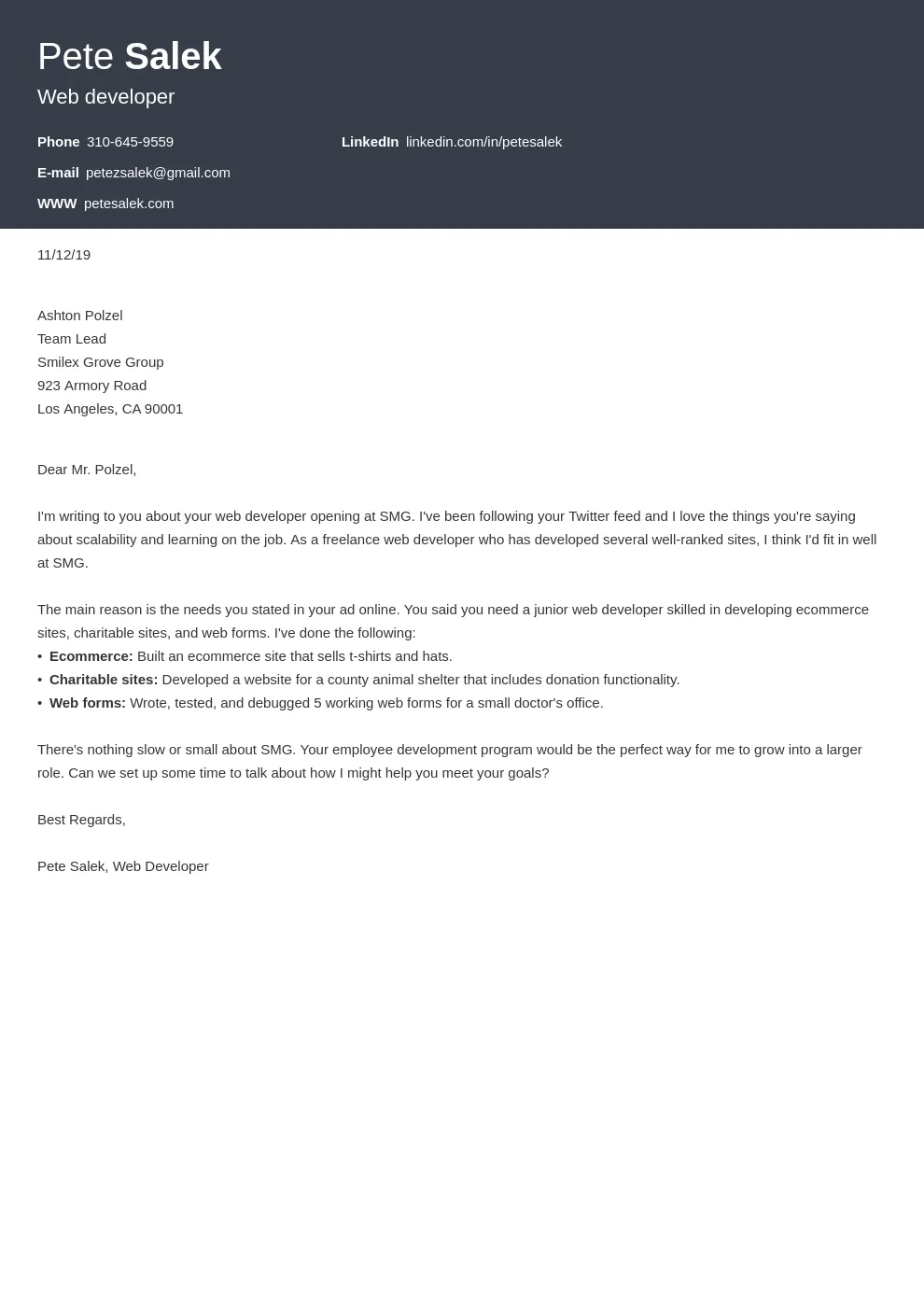
Your cover letter should prominently feature the technical skills and technologies you’re proficient in. This is where you showcase your ability to work with programming languages like HTML, CSS, JavaScript, and various frameworks such as React, Angular, or Vue.js. Be sure to tailor this section to the specific requirements outlined in the job description. If the role emphasizes a particular technology, make sure to highlight your experience with it. Demonstrate your understanding of web development fundamentals, including responsive design, cross-browser compatibility, and user experience (UX) principles. Highlight relevant experience with database management, server-side scripting, and version control systems like Git.
Showcasing Projects and Achievements
Instead of simply listing your projects, use your cover letter to describe your role in those projects, the technologies used, and the outcomes achieved. Quantify your achievements whenever possible, such as by mentioning the increase in website traffic, the reduction in bounce rate, or the improvement in user engagement. Provide brief descriptions of your contributions to each project and the challenges you overcame. For example, you might describe how you optimized website performance, implemented new features, or improved the user interface.
Tailoring Your Cover Letter
Avoid using a generic, one-size-fits-all cover letter. Always customize your letter for each job application. This involves researching the company, understanding the job requirements, and aligning your skills and experience accordingly. A tailored cover letter demonstrates your genuine interest in the specific role and the company’s mission.
Researching the Company and Job Requirements
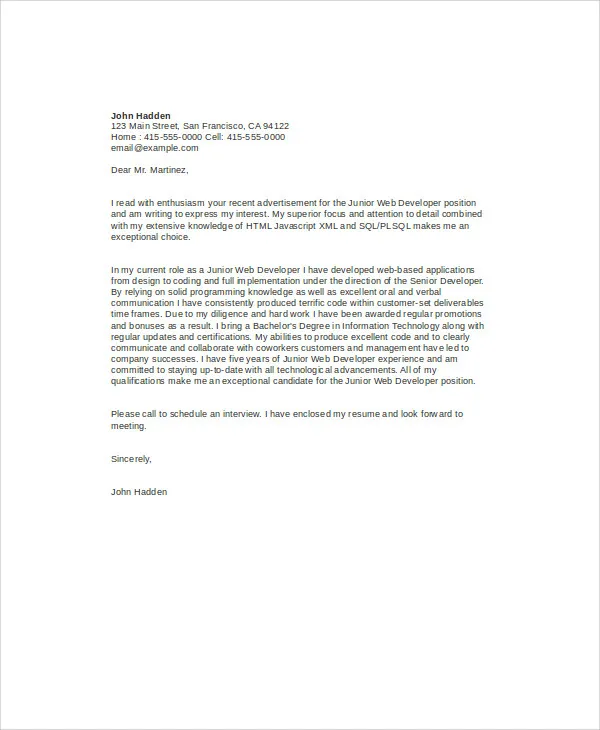
Before you start writing, thoroughly research the company. Visit their website, read their mission statement, and check out their social media profiles. Understand their products or services, their company culture, and their current projects. Carefully analyze the job description and identify the key skills, experience, and qualifications the employer is seeking. This will guide you in highlighting the most relevant aspects of your background.
Personalizing Your Letter for Maximum Impact
Use the company’s name and the hiring manager’s name, if you can find it. Reference specific aspects of the company or the job description to demonstrate your genuine interest. Explain why you’re excited about the opportunity and how your skills align with the company’s needs. Address the specific requirements mentioned in the job description, and explain how your experience makes you a good fit.
Structuring Your Cover Letter
A well-structured cover letter is easy to read and makes a positive impression. It typically follows a standard format with an introduction, body paragraphs, and a conclusion.
Header Information and Contact Details
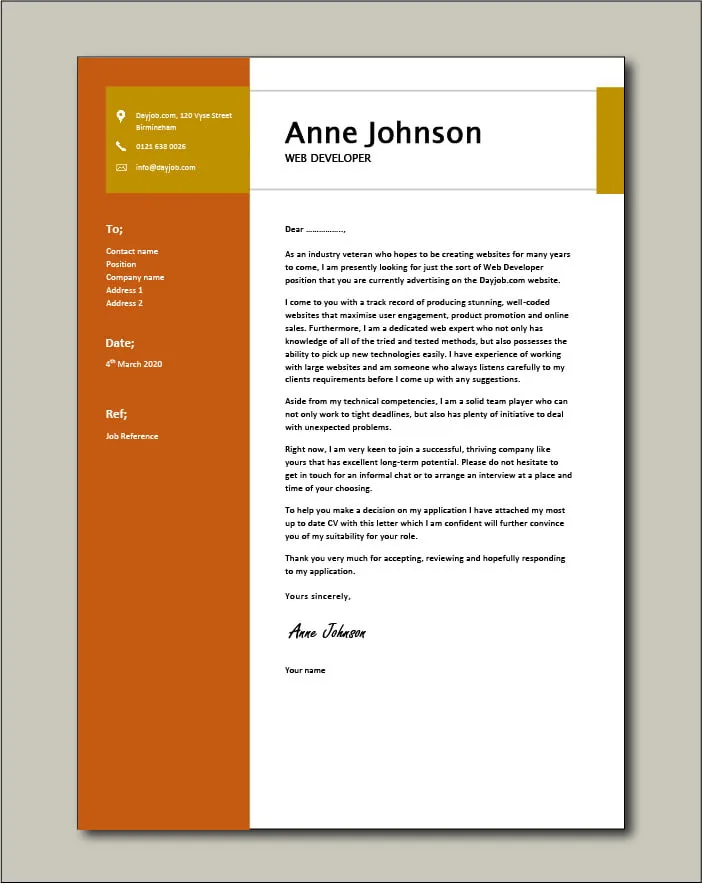
Include your contact information at the top of the letter, including your name, phone number, email address, and LinkedIn profile URL. Also include the date and the hiring manager’s name and title, if available. Ensure your contact information is current and professional-looking.
Opening Paragraph A Strong Start
Your opening paragraph should immediately capture the reader’s attention. State the position you’re applying for and where you found the job posting. Briefly mention why you’re interested in the role and the company. Express your enthusiasm and highlight your key qualifications to create a positive first impression.
Body Paragraphs Showcasing Experience
Use the body paragraphs to expand on your skills, experience, and achievements. Tailor these paragraphs to the specific requirements of the job description. Provide specific examples of your accomplishments and quantify them whenever possible. Demonstrate how your skills and experience align with the company’s needs. You can use a few paragraphs to highlight your relevant projects and your role in those projects.
Closing Paragraph Call to Action
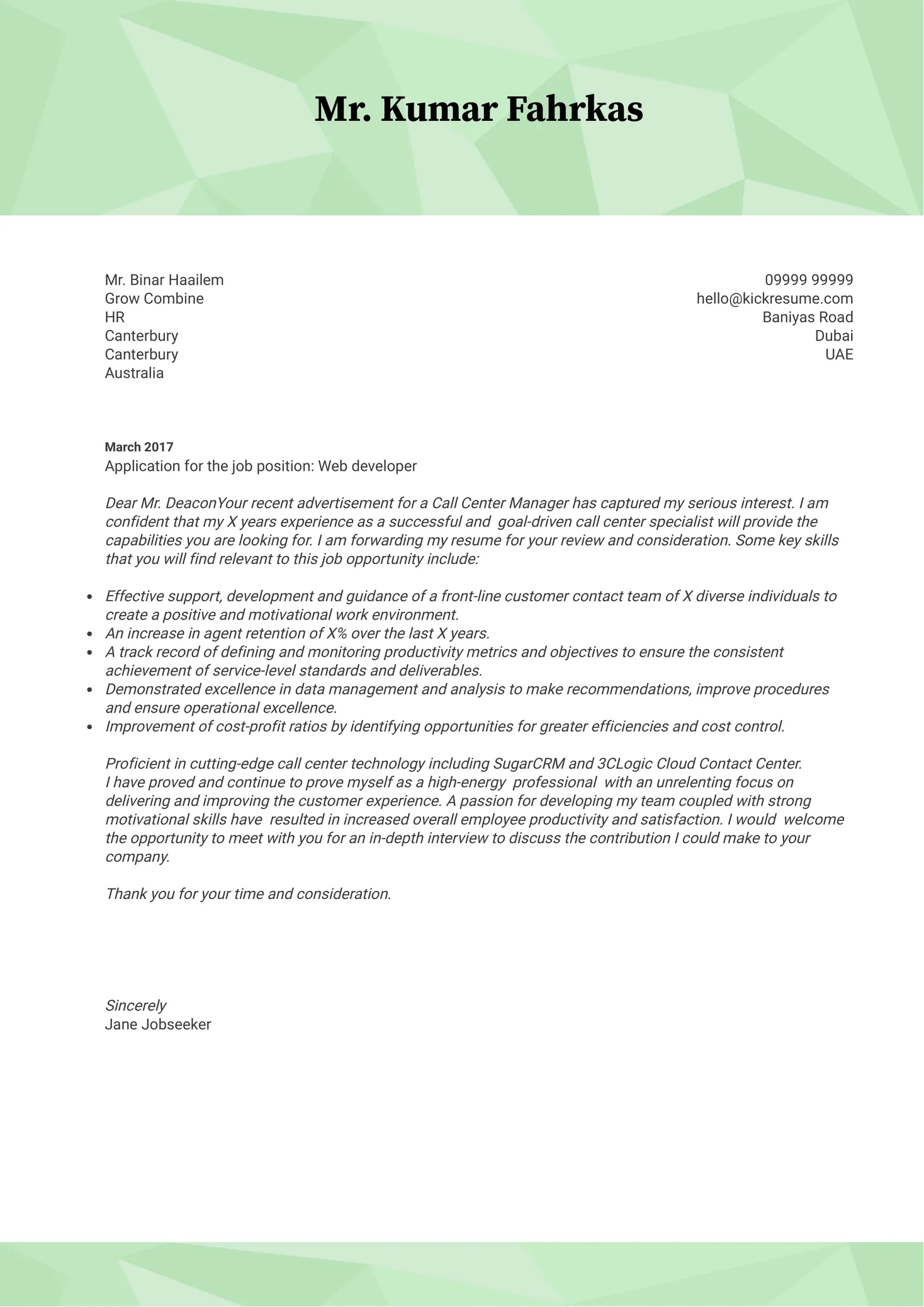
In your closing paragraph, reiterate your interest in the position and the company. Thank the hiring manager for their time and consideration. Include a clear call to action, such as stating that you’re eager to discuss your qualifications further and are available for an interview. Make it easy for the recruiter to contact you.
Formatting and Design for Readability
Your cover letter should be visually appealing and easy to read. Use a professional font like Arial, Calibri, or Times New Roman, and use a font size between 10 and 12 points. Maintain consistent formatting throughout the document. Use clear headings, bullet points, and white space to break up the text and make it more readable. Keep the letter concise and avoid long paragraphs.
Proofreading and Editing
Always proofread your cover letter carefully for any typos, grammatical errors, or spelling mistakes. Have a friend or colleague review your letter as well. Ensure that your language is clear, concise, and professional. Pay attention to sentence structure and flow to create a polished document.
Common Mistakes to Avoid
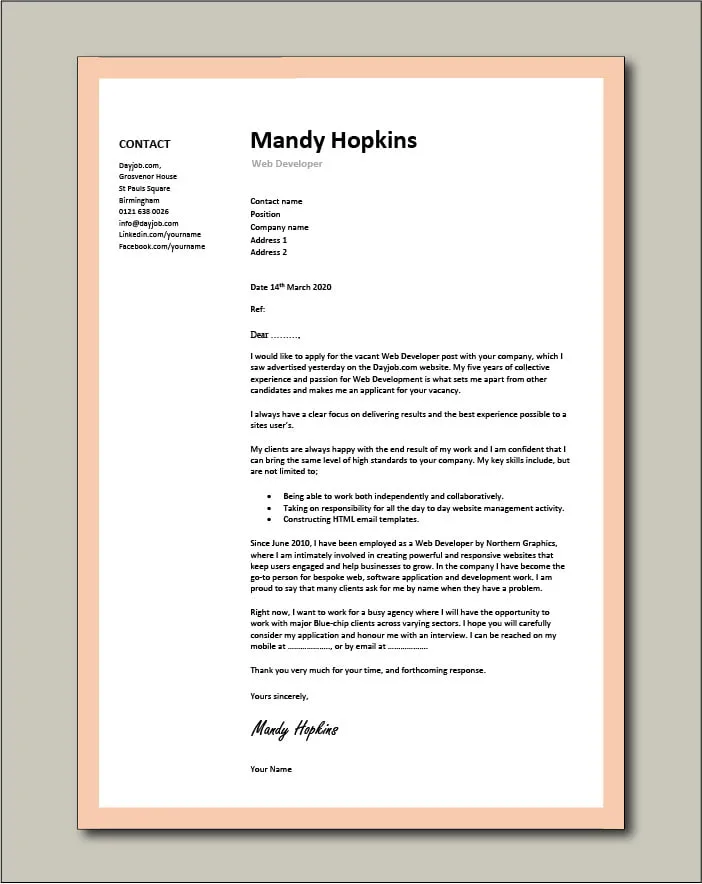
Avoid these common pitfalls to ensure your cover letter makes a positive impression:
Generic Language and Lack of Personalization
Avoid using generic phrases that could apply to any job. Tailor your letter to the specific role and company. Show that you’ve taken the time to understand the requirements and are genuinely interested in the opportunity. Personalize your letter by referencing specific aspects of the company or the job description.
Typos and Grammatical Errors
Typos and grammatical errors can undermine your credibility. Always proofread your letter carefully before submitting it. Use a spell checker and grammar checker, and have someone else review your letter as well. Ensure that your language is clear, concise, and error-free.
Ignoring Job Requirements
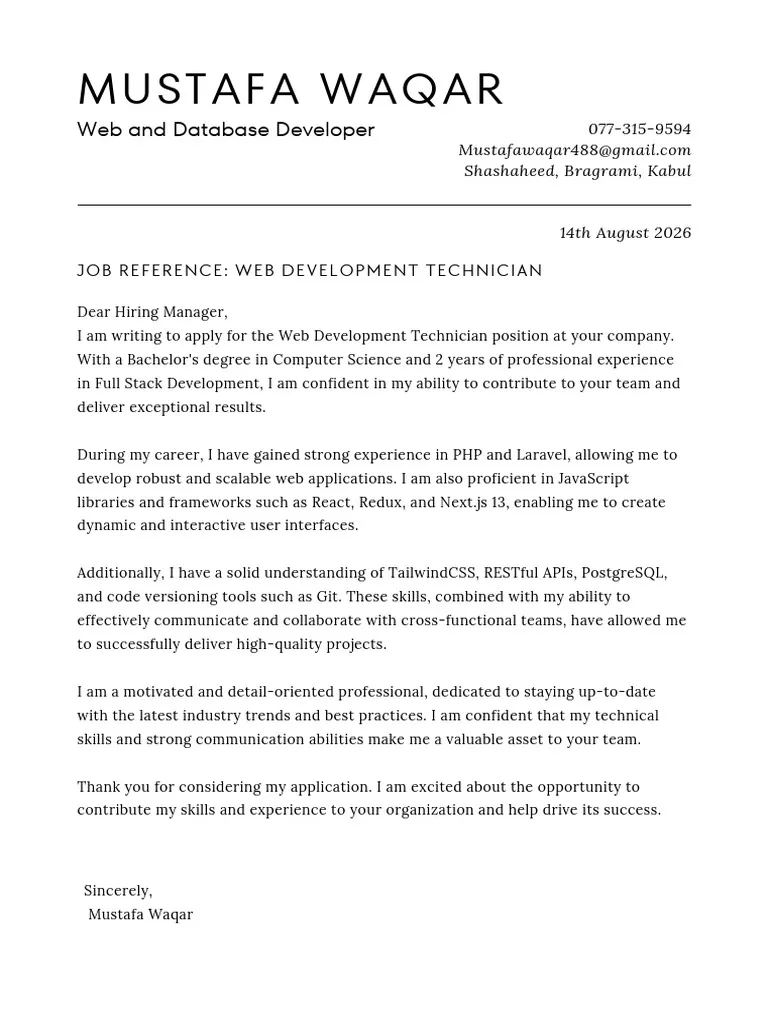
Carefully read the job description and address the specific requirements in your cover letter. Show how your skills and experience align with the company’s needs. Demonstrate your ability to meet the expectations of the role. Failing to address the requirements can indicate a lack of attention to detail and a lack of suitability for the position.
Tips for Standing Out
Here are some tips to help your cover letter stand out from the competition:
Quantifying Achievements with Numbers
Use numbers to quantify your achievements whenever possible. For example, mention the percentage increase in website traffic, the number of users your application supports, or the reduction in development time. Quantifiable achievements demonstrate the impact of your work.
Demonstrating Passion and Enthusiasm
Show your genuine interest in the role and the company. Mention specific aspects of the company that excite you, and explain why you’re enthusiastic about the opportunity. Your passion and enthusiasm can help you make a strong connection with the hiring manager.
Mentioning Relevant Projects
Highlight projects that are relevant to the job requirements. Describe your role in each project, the technologies used, and the results achieved. Providing specific examples of your accomplishments will help demonstrate your skills and experience.
Using Action Verbs
Start your sentences with strong action verbs to make your cover letter more dynamic and engaging. Action verbs help to highlight your accomplishments and make a more positive impression. Examples include developed, implemented, designed, optimized, managed, and collaborated.
Cover Letter Examples for Web Developers
Here are some example cover letter structures and snippets, tailored to different experience levels. Remember to adapt these examples to your own skills and experiences, and always personalize the letter to the specific job and company.
Entry-Level Web Developer Cover Letter Example
Focus on showcasing skills learned through education, personal projects, and internships. Highlight any coursework or certifications relevant to the job. Mention any contributions to open-source projects or personal portfolio websites. Emphasize your eagerness to learn and your ability to adapt quickly.
Mid-Level Web Developer Cover Letter Example
Highlight your experience in developing and maintaining web applications. Provide specific examples of projects you’ve worked on, the technologies you’ve used, and the results you’ve achieved. Mention your problem-solving skills, teamwork abilities, and experience with different development methodologies (such as Agile). Include quantifiable achievements whenever possible.
Senior Web Developer Cover Letter Example
Emphasize your leadership skills, project management experience, and technical expertise. Mention any experience mentoring junior developers or leading development teams. Highlight your ability to make strategic decisions, solve complex problems, and contribute to the overall success of projects. Demonstrate your deep understanding of web development best practices and your ability to drive innovation.
Final Thoughts and Next Steps
Crafting a compelling cover letter is a crucial step in securing a web developer position. By following these guidelines, tailoring your letter to each application, and demonstrating your passion and enthusiasm, you can significantly increase your chances of landing an interview. Remember to proofread your letter carefully and customize it to the job and company.
Submitting Your Cover Letter
When submitting your cover letter, make sure to follow the instructions provided in the job posting. If the company requires a specific format or file type, adhere to those guidelines. Double-check all attachments and ensure that the cover letter is correctly addressed to the hiring manager.
Following Up on Your Application
If you haven’t heard back from the employer within a reasonable timeframe (usually one to two weeks), it’s acceptable to send a follow-up email. Express your continued interest in the position and reiterate your qualifications. Keep the email concise and professional. A follow-up can demonstrate your persistence and enthusiasm.
